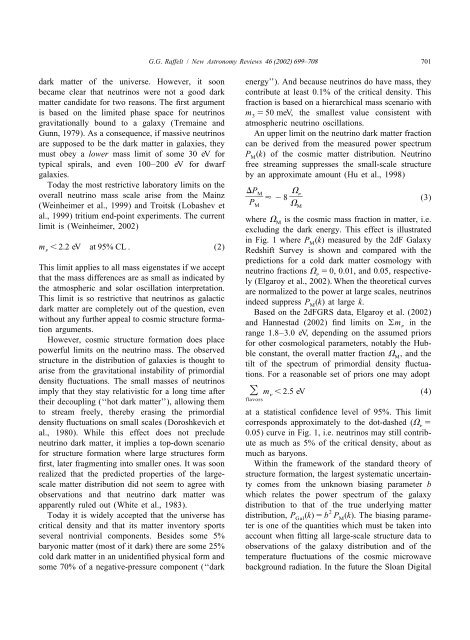Neutrino masses in astroparticle physics - MPP Theory Group
Neutrino masses in astroparticle physics - MPP Theory Group
Neutrino masses in astroparticle physics - MPP Theory Group
Create successful ePaper yourself
Turn your PDF publications into a flip-book with our unique Google optimized e-Paper software.
G.G. Raffelt / New Astronomy Reviews 46 (2002) 699–708 701dark matter of the universe. However, it soon energy’’). And because neutr<strong>in</strong>os do have mass, theybecame clear that neutr<strong>in</strong>os were not a good dark contribute at least 0.1% of the critical density. Thismatter candidate for two reasons. The first argument fraction is based on a hierarchical mass scenario withis based on the limited phase space for neutr<strong>in</strong>os m35 50 meV, the smallest value consistent withgravitationally bound to a galaxy (Trema<strong>in</strong>e and atmospheric neutr<strong>in</strong>o oscillations.Gunn, 1979). As a consequence, if massive neutr<strong>in</strong>os An upper limit on the neutr<strong>in</strong>o dark matter fractionare supposed to be the dark matter <strong>in</strong> galaxies, they can be derived from the measured power spectrummust obey a lower mass limit of some 30 eV for PM(k) of the cosmic matter distribution. <strong>Neutr<strong>in</strong>o</strong>typical spirals, and even 100–200 eV for dwarf free stream<strong>in</strong>g suppresses the small-scale structuregalaxies. by an approximate amount (Hu et al., 1998)Today the most restrictive laboratory limits on theDPMVoverall neutr<strong>in</strong>o mass scale arise from the Ma<strong>in</strong>zn]] ¯ 2 8 ](We<strong>in</strong>heimer et al., 1999) and Troitsk (Lobashev et PMVM(3)al., 1999) tritium end-po<strong>in</strong>t experiments. The current where VMis the cosmic mass fraction <strong>in</strong> matter, i.e.limit is (We<strong>in</strong>heimer, 2002)exclud<strong>in</strong>g the dark energy. This effect is illustratedm , 2.2 eV at 95% CL . (2)n<strong>in</strong> Fig. 1 where PM(k) measured by the 2dF GalaxyRedshift Survey is shown and compared with thepredictions for a cold dark matter cosmology withneutr<strong>in</strong>o fractions Vn5 0, 0.01, and 0.05, respective-ly (Elgaroy et al., 2002). When the theoretical curvesThis limit applies to all mass eigenstates if we acceptthat the mass differences are as small as <strong>in</strong>dicated bythe atmospheric and solar oscillation <strong>in</strong>terpretation. are normalized to the power at large scales, neutr<strong>in</strong>osThis limit is so restrictive that neutr<strong>in</strong>os as galactic <strong>in</strong>deed suppress PM(k) at large k.dark matter are completely out of the question, even Based on the 2dFGRS data, Elgaroy et al. (2002)without any further appeal to cosmic structure forma- and Hannestad (2002) f<strong>in</strong>d limits on omn<strong>in</strong> thetion arguments.range 1.8–3.0 eV, depend<strong>in</strong>g on the assumed priorsHowever, cosmic structure formation does place for other cosmological parameters, notably the Hubpowerfullimits on the neutr<strong>in</strong>o mass. The observed ble constant, the overall matter fraction VM, and thestructure <strong>in</strong> the distribution of galaxies is thought to tilt of the spectrum of primordial density fluctuaarisefrom the gravitational <strong>in</strong>stability of primordial tions. For a reasonable set of priors one may adoptdensity fluctuations. The small <strong>masses</strong> of neutr<strong>in</strong>osimply that they stay relativistic for a long time after O mn, 2.5 eV (4)flavorstheir decoupl<strong>in</strong>g (‘‘hot dark matter’’), allow<strong>in</strong>g themto stream freely, thereby eras<strong>in</strong>g the primordial at a statistical confidence level of 95%. This limitdensity fluctuations on small scales (Doroshkevich et corresponds approximately to the dot-dashed (V n5al., 1980). While this effect does not preclude 0.05) curve <strong>in</strong> Fig. 1, i.e. neutr<strong>in</strong>os may still contribneutr<strong>in</strong>odark matter, it implies a top-down scenario ute as much as 5% of the critical density, about asfor structure formation where large structures form much as baryons.first, later fragment<strong>in</strong>g <strong>in</strong>to smaller ones. It was soon With<strong>in</strong> the framework of the standard theory ofrealized that the predicted properties of the large- structure formation, the largest systematic uncerta<strong>in</strong>scalematter distribution did not seem to agree with ty comes from the unknown bias<strong>in</strong>g parameter bobservations and that neutr<strong>in</strong>o dark matter was which relates the power spectrum of the galaxyapparently ruled out (White et al., 1983).distribution to that of the true underly<strong>in</strong>g matter2Today it is widely accepted that the universe has distribution, PGal(k) 5 b PM(k). The bias<strong>in</strong>g paramecriticaldensity and that its matter <strong>in</strong>ventory sports ter is one of the quantities which must be taken <strong>in</strong>toseveral nontrivial components. Besides some 5% account when fitt<strong>in</strong>g all large-scale structure data tobaryonic matter (most of it dark) there are some 25% observations of the galaxy distribution and of thecold dark matter <strong>in</strong> an unidentified physical form and temperature fluctuations of the cosmic microwavesome 70% of a negative-pressure component (‘‘dark background radiation. In the future the Sloan Digital













